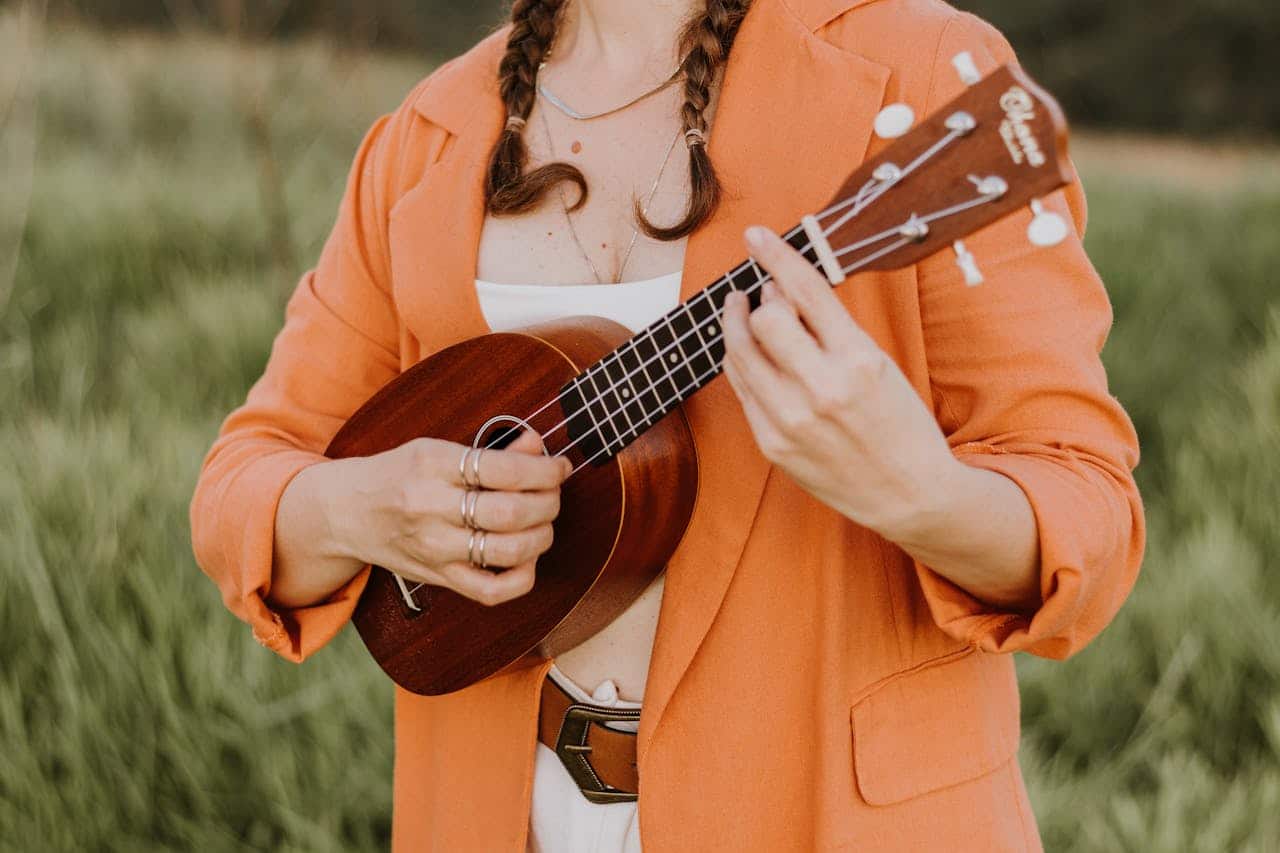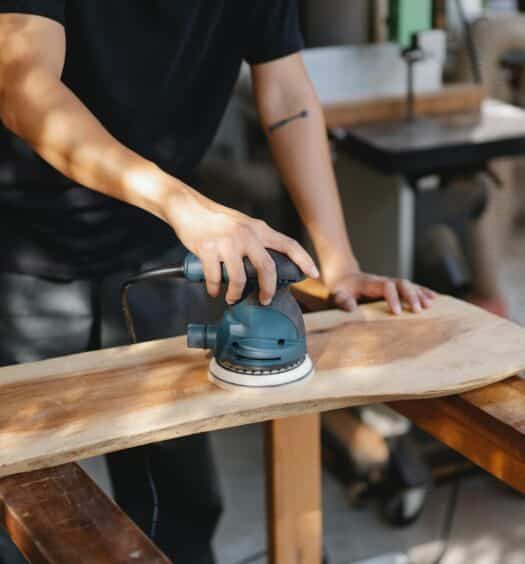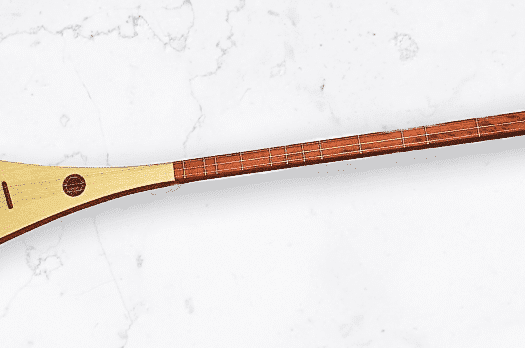The last time I took my family on a car trip, I decided to bring my dulcimer. But as I watched my wife cramming more and more bags into our hatchback, I started to get concerned about whether my dulcimer was safe. It got me thinking… are there better, more portable musical instruments for travelling?
I decided to research some fun options for our family, and stumbled upon a few gems. In this post, I offer 12 fun, portable musical instruments that work well for travelling. Some of these are old standbys, like the ukulele or harmonica. Others, however, are a bit more unique. But all certainly make for interesting road trips.
Let’s take a look.
Ukelele
A ukulele is a small, four-stringed musical instrument of the lute family. It originated in the 19th century in Hawaii, and it is typically made of wood.
The ukulele typically comes in four sizes: soprano, concert, tenor, and baritone, each producing a slightly different tone and pitch range. It’s known for its bright, cheerful sound and is commonly used in a variety of music genres, from traditional Hawaiian music to contemporary pop and folk.
Donner makes a great affordable beginner kit that features a high quality 23″ mahogany ukulele. It also comes with a bunch of useful accessories, including gig bag, strap, tuner, 4 extra Aquila nylon strings, 4 picks and cleaning cloth.
Donner Concert Ukulele Beginner Kit 23 inch
Harmonica
The quintessential travel instrument, the harmonica is a small, rectangular wind instrument known for its bluesy sound. The harmonica is played by blowing air into or drawing air out of multiple holes, which are connected to reeds that produce sound.
There are several types of harmonicas, but the most common is the diatonic harmonica. Typically used in blues, rock, and folk music, the diatonic is designed to play in a specific key.
Fender makes a great diatonic harmonica in the key of C, which comes with a carrying case, polishing cloth, and instructional manual. Perfect when travelling solo.
Fender Blues Deluxe Harmonica
Kazoo
Everyone remembers the kazoo. A kazoo is a small, simple musical instrument that produces sound when the player hums into it. Unlike most instruments, the kazoo modifies the player’s voice by amplifying the vibrations of their vocal cords through a membrane inside the instrument. This is what creates that familiar buzzing sound.
The Blue Kazoo is a step up from the cheap plastic kazoos I remember from my youth, but in a timeless design. It’s also a great way to get your kids off their screens when travelling.
But be forewarned. Too much kazooing in the tight confines of a family car may be enough to drive you crazy.
The Original Blue Kazoo
Ocarina
An ocarina is a type of wind musical instrument with an ancient history, believed to have originated over 12,000 years ago. Uniquely shaped, it is traditionally made from materials such as ceramic, clay, or plastic.
The ocarina typically has a mouthpiece and several finger holes (usually between 4 and 12). By covering and uncovering holes while blowing air into the instrument you can produce different pitches. The sound of an ocarina is often described as sweet and flute-like, but is much more affordable than a flute.
Fans on the video game series “The Legend of Zelda,” may recall the use of the ocarina where it plays a central role in the storyline and gameplay. This plastic ocarina is both light and durable, and is particularly popular with our family on road trips.
12-Holed Ocarina (Key of C)
Musical Spoons
I remember visiting a pub in Dublin with my wife and enjoying a local band playing traditional Irish music. One of the performers used musical spoons and left me entranced. That experience left a lasting impression on me, and I vowed to learn how to play them when I returned to the US.
Musical spoons are a simple, yet traditional percussion instrument consisting of two spoons held back-to-back. They are played by striking them against each other, or against the player’s knee, hand, or another surface to create rhythmic clacking sounds. This instrument is often associated with folk music and street performances.
A quintessential portable instrument, the spoons are great fun to play, both alone or with a band. They are inexpensive, lightweight, and fit in your pocket. And while they take some practice to master, the spoons deliver crisp percussion that can accompany any of the other travel-sized instruments in this post.
Heritage Musical Spoons Percussion Instrument (Maple)
Tongue Drum
The tongue drum is another great pocket-sized instrument for travelling. Also known as a tank drum or steel tongue drum, the tongue drum is a type of percussion instrument that produces melodious tones when struck.
It is typically made from a round, hollow metal shell with several slits or “tongues” cut into the top surface. Each tongue is a different length and width. These differences allow it to produce distinct pitches when struck with fingers or mallets.
The tongue drum is a great pocket-sized instrument for little ones looking for things to do on a long road trip. The instrument is intuitive, easy to learn, and its soft sound is pleasant to listen to. It’s also small, durable, and can easily fit in a backpack.
15-Note Steel Tongue Drum (Key of D)
Stylophone
A Stylophone is just cool. It is a small, portable electronic musical instrument that was invented in 1967 by Brian Jarvis and the Dübreq Company. It is played using a stylus, which the player taps or slides across a metal keyboard to produce notes.
The stylus gained popularity in the late 1960s and 1970s, notably used by artists like David Bowie, and delivers a unique, “Moog”-like vintage sound.
The stylophone is also portable, typically battery-powered, and makes for a fun travel-sized instrument. It also comes with an aux jack for headphones, which makes it appealing for car trips.
Below is a video of David Bowie in 2002 playing the stylophone in Berlin, Germany in his song “Slip Away”.
Stylophone – The Original Pocket Electronic Synthesizer
Travel Didgeridoo
A didgeridoo is a wind instrument developed by Indigenous Australians of northern Australia, and is traditionally made from hollowed-out eucalyptus wood. It is considered one of the oldest musical instruments in the world. Some origins are estimated to be around 1,500 years old.
Traditional didgeridoos, however, range anywhere from 3 -10 feet in length. This obviously makes travelling with one difficult. Enter the travel didgeridoo.
Travel didgeridoos are light and compact, and a great alternative when travelling. Despite their non-traditional shape, they produce deep overtones and a full drone just like a traditional didgeridoo… but in a scaled-down size.
Meinl, a well-respected German manufacturer of quality instruments from the early 50s, makes a great travel didgeridoo and is features below. Another awesome portable instrument option to consider.
Meinl Percussion DDG-BOX Compact Travel Didgeridoo (Mahogany)
Kalimba
A kalimba, also known as a thumb piano, is a type of idiophone that originates from Africa. It consists of a wooden board or resonator with attached metal tines of varying lengths.
(An idiophone is any musical instrument that creates sound by the vibration of the instrument itself, and not from air flow.)
The metal tines are the keys of the kalimba. When the tines are plucked with the thumbs or fingers, they produce melodic and resonant tones. Each tine is of a different length, producing different pitches. The longer tines produce lower notes, while the shorter ones produce higher notes.
The kalimba is a great portable instrument due to its small size and mellow tones. The model below is approximately 7″ long and 5″ wide, which fits in a large purse or back pack.
The kalimba featured below includes tune hammer, instruction book, stickers, flannelette bag, and cleaning fabric.
17-Key Kalimba/Thumb Piano
Melodica
A melodica is a free-reed instrument similar to a harmonica but played with a keyboard. It is also sometimes known as a “blow-organ” or “key-flute.” When playing the melodica, you blow air into the instrument through a mouthpiece or a flexible tube. As the air passes through reeds, it produces sound. Each key opens a valve, allowing air to flow through a specific reed.
A typical melodica ranges from 2-3 octaves. But what does it sound like? The melodica is often described as a combination of the harmonica and the accordion. Check out the video below.
We love the melodica. Not only is it relatively small and 100% acoustic, but it has huge range and allows for very expressive playing ability and soft to loud dynamics. It can also play chords which makes it useful in a band setting.
32-Key Melodica with Carrying Bag
Otamatone
The Otamatone is a unique and whimsical electronic musical instrument that resembles a musical note character. It was invented in Japan by Novmichi Tosa of the Maywa Denki design firm.
To produce sound, the player squeezes the flexible stem (which acts as the mouth of the character) and presses their fingers along the neck’s touch-sensitive ribbon. This alters the pitch and tone of the sound produced by an internal speaker.
Gimmicky? Yes, possibly. But our younger ones absolutely love it.
Otamatone “Neo 10th Anniversary Special Edition
Jaw Harp
The jaw harp is a hand-held instrument that contains a flexible reed in a solid frame and it meant to be played in the musician’s mouth. It is held against the musician’s teeth or lips, and when he/she flicks the flexible reed a sound is produced. This produces the characteristic “boing” sound the jaw harp is known for.
The jaw harp is great for road trips. It’s small enough to put in your pocket, has no moving parts and doesn’t require any tuning. It’s also fun, unique and inexpensive.
And for musicians, the jaw harp’s unique sound provides interest and depth when performing blues and folk music.
Check out our post on the Best Jaw Harps for additional ideas.
Altay Jew’s Harp for Beginners
Final Words
We hope you found this post useful for exploring unique instrument ideas for travelling. Some of these ideas, such as the harmonica, are certainly not new or unique. But there are many other options that are interesting and fun to try.
We’ve had success with many of these, but see what works for you!












![Otamatone "Neo 10th Anniversary Special Edition [Japanese Version] White - Japanese Electronic Musical Instrument Synthesizer](https://m.media-amazon.com/images/I/21WteJP5YuL._SL500_.jpg)



